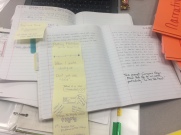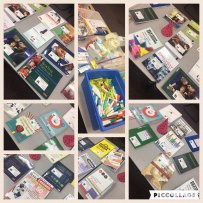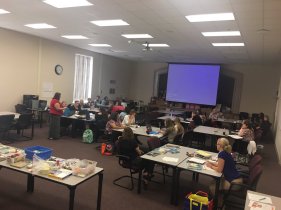Conferrin g is one of the most important parts of our class period. Research is overwhelming on the benefits of real time feedback. And while I believe in the power of research, I was really sold on conferencing when I saw the difference it made my students. It is one of the most powerful moves I can make to help my students grow in reading and writing.
g is one of the most important parts of our class period. Research is overwhelming on the benefits of real time feedback. And while I believe in the power of research, I was really sold on conferencing when I saw the difference it made my students. It is one of the most powerful moves I can make to help my students grow in reading and writing.
As I’ve learned more about conferring, I’ve come to understand that the teacher and student tools I use must be purposeful and strategic. After professional development opportunities–particularly with Teacher’s College, some friends and I decided we needed tim e to build the tools together. So our district organized a 6-12 grade teacher toolkit party!
e to build the tools together. So our district organized a 6-12 grade teacher toolkit party!
The goal of this party was to gather resources for teacher tools and give time for teachers to work together building toolkits. We had around 30 teachers join together on a Wednesday from 3:30-5:00 pm to work together. It was amazing!
We were particularly grateful to Jennifer Serravallo and Kate and Maggie Roberts for not only all their published resources, which are without a doubt some of the best out there, but also for taking time to send us some advice for our party.
 Since our main goal at the party was to create tools and toolkits, I did not give as much introduction to conferring and the use of tools. Teachers were all in varying places with conferring work, so I’ve added more information for those who would like it. Below is what we used at our party, as well as the additional resources (with links!) for conferring work. Or you can view the informational Sway.
Since our main goal at the party was to create tools and toolkits, I did not give as much introduction to conferring and the use of tools. Teachers were all in varying places with conferring work, so I’ve added more information for those who would like it. Below is what we used at our party, as well as the additional resources (with links!) for conferring work. Or you can view the informational Sway.
I would love share ideas from others who do something similar to toolkit parties.
Conferring Toolkit Basics
“Conferring is not the icing on the cake; it is the cake.” -Carl Anderson, aka Conferring Carl
“Real time feedback is the number one thing that is going to close the achievement gap.” Cris Tovani
Why confer?
- Conferring with students is the heart of workshop.
- It allows teachers to give timely feedback to students.
- It allows teachers to build relationships with the readers and writers in their classrooms.
- It builds community in the classroom among students.
- It helps give students the tools they need to lift the level of their reading and writing immediately.
Types of Conferences:
- One-on-one (teacher and student)
- Partnership (teacher and two students or student and student)
- Table (teacher and students sitting together in one group)
- Small Group (teacher and strategically pulled group of students)
Conferring Resources:
- How to Make Conferring Better in Our Classrooms
- Conferring Resources on ELA Resources Pinterest Page
- Teachers College Videos
- Penny Kittle Videos: Reading Conferences and Writing Conferences
What is a teaching tool?
Tools …
- improve our students’ work*
- help our students build agency and independence*
- make teaching clear by answering: how do readers and writers actually do that?*
- help organize and bring clarity to the strategies in your classroom*
- keeps strategies front and center and allows students to refer to them even after the lesson is over*
- they help learning stick*
Tools …
- are visual*
- make the abstract concrete*
- encourage repeated practice*
Tools are not …
- simply handouts
- worksheets
- too wordy
*taken from Kate Roberts & Maggie Roberts, DIY Literacy
Types of effective teaching tools…
- Charts
- Demonstration Notebooks
- Micro-progressions of skills
- Bookmarks
- Model Notebooks
- Mentor texts
- Student writing
- Tips/strategies to leave with student
- Mini-charts
- Student tools
**Some of these overlap and some can be housed within notebooks.
Teaching Tools Resources:
- Kate and Maggie’s DIY Literacy Video Series (A MUST!!!)
- Kate and Maggie’s Webinar for DIY Literacy (Scroll down to bottom of page)
- DIY Literacy Book
- The Reading Strategies Book and Study Guide (Study Guide is linked on this page)
- Jennifer Serravallo’s Reading Strategies Book webinar
- Jennifer Serravallo’s website
What is a toolkit?
A toolkit is where you house your teaching tools. Teacher toolkits will have different tools depending on the teacher’s goals. There is also a lot of flexibility in how the teacher decides to house the tools.
Another toolkit that might be used is a student toolkit. This would be where you house tools for students so they can easily access them.
What might go in your toolkit?
- Color code (with sticky notes) a page of text to know what to use or lenses (green—sentence structure; pink—craft moves; yellow—structure of text; blue—example of a try it)
- Color code an essay (green—structure; purple—craft; black—grammar)
- Craft cards in bags
- Prompts to leave behind
- Checklists
- Progressions—broken into sections like leads, elaboration, evidence, etc—points with a sticky note of examples
- Marked up mentor texts (student text, professional text, teacher text)
- Demo writing at different level
- Mini-charts
- Leave-behinds (prompts, reminders…)
- If/then pages
- Assessment items (rubrics, checklists, etc)
- My reader/writer notebook
- Sticky notes, highlighters, markers, etc.
- Anchor texts
How could a toolkit be organized?
- Categories—Structure, elaboration, craft, conventions
- Writing Process Stages—generating, developing, drafting, revising, editing
- Folder system, binder with page protectors, sketch book, pony folders
**Tools can be housed electronically, as well. Suggested resources: Evernote or OneNote
Toolkit Resources:
- Teacher Toolkit Resources on ELA Resources Wall Pinterest
- https://twowritingteachers.org/2013/09/16/teaching-toolkits/
- https://twowritingteachers.org/2014/06/25/a-writing-teachers-summer-project-building-a-teaching-toolkit/
- https://twowritingteachers.org/2014/01/15/masterwnevernote/
- https://toolkitteacher.wordpress.com/
- http://www.scholastic.com/teachers/top-teaching/2013/09/creating-readerswriters-toolkit
- http://www.scholastic.com/teachers/top-teaching/2013/10/using-readerswriters-toolkit-classroom-part-2
We will be posting examples we’ve made on Twitter and Instagram with the hashtags #hocoela #toolkit — keep checking to see if your toolkit or tool has been featured!
Twitter: @hocoela and @WallChristie
Instagram: @elacoachwall
